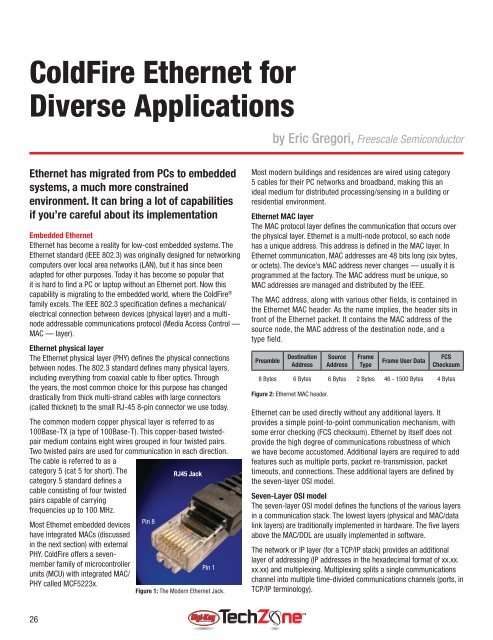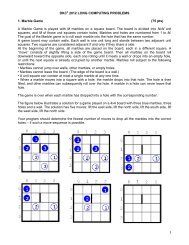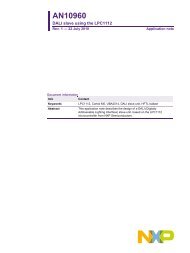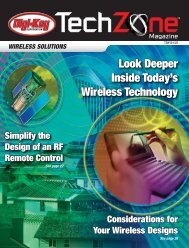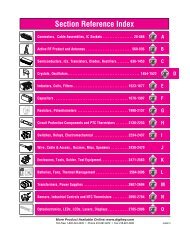Microcontroller Solutions TechZone Magazine, April 2011 - Digikey
Microcontroller Solutions TechZone Magazine, April 2011 - Digikey
Microcontroller Solutions TechZone Magazine, April 2011 - Digikey
Create successful ePaper yourself
Turn your PDF publications into a flip-book with our unique Google optimized e-Paper software.
ColdFire Ethernet for<br />
Diverse Applications<br />
by Eric Gregori, Freescale Semiconductor<br />
Ethernet has migrated from PCs to embedded<br />
systems, a much more constrained<br />
environment. It can bring a lot of capabilities<br />
if you’re careful about its implementation<br />
Embedded Ethernet<br />
Ethernet has become a reality for low-cost embedded systems. The<br />
Ethernet standard (IEEE 802.3) was originally designed for networking<br />
computers over local area networks (LAN), but it has since been<br />
adapted for other purposes. Today it has become so popular that<br />
it is hard to fi nd a PC or laptop without an Ethernet port. Now this<br />
capability is migrating to the embedded world, where the ColdFire ®<br />
family excels. The IEEE 802.3 specifi cation defi nes a mechanical/<br />
electrical connection between devices (physical layer) and a multinode<br />
addressable communications protocol (Media Access Control —<br />
MAC — layer).<br />
Ethernet physical layer<br />
The Ethernet physical layer (PHY) defi nes the physical connections<br />
between nodes. The 802.3 standard defi nes many physical layers,<br />
including everything from coaxial cable to fi ber optics. Through<br />
the years, the most common choice for this purpose has changed<br />
drastically from thick multi-strand cables with large connectors<br />
(called thicknet) to the small RJ-45 8-pin connector we use today.<br />
The common modern copper physical layer is referred to as<br />
100Base-TX (a type of 100Base-T). This copper-based twistedpair<br />
medium contains eight wires grouped in four twisted pairs.<br />
Two twisted pairs are used for communication in each direction.<br />
The cable is referred to as a<br />
category 5 (cat 5 for short). The<br />
RJ45 Jack<br />
category 5 standard defi nes a<br />
cable consisting of four twisted<br />
pairs capable of carrying<br />
frequencies up to 100 MHz.<br />
Pin 8<br />
Most Ethernet embedded devices<br />
have integrated MACs (discussed<br />
in the next section) with external<br />
PHY. ColdFire offers a sevenmember<br />
family of microcontroller<br />
Pin 1<br />
units (MCU) with integrated MAC/<br />
PHY called MCF5223x.<br />
Figure 1: The Modern Ethernet Jack.<br />
Most modern buildings and residences are wired using category<br />
5 cables for their PC networks and broadband, making this an<br />
ideal medium for distributed processing/sensing in a building or<br />
residential environment.<br />
Ethernet MAC layer<br />
The MAC protocol layer defi nes the communication that occurs over<br />
the physical layer. Ethernet is a multi-node protocol, so each node<br />
has a unique address. This address is defi ned in the MAC layer. In<br />
Ethernet communication, MAC addresses are 48 bits long (six bytes,<br />
or octets). The device’s MAC address never changes — usually it is<br />
programmed at the factory. The MAC address must be unique, so<br />
MAC addresses are managed and distributed by the IEEE.<br />
The MAC address, along with various other fields, is contained in<br />
the Ethernet MAC header. As the name implies, the header sits in<br />
front of the Ethernet packet. It contains the MAC address of the<br />
source node, the MAC address of the destination node, and a<br />
type field.<br />
Preamble<br />
Destination<br />
Address<br />
Figure 2: Ethernet MAC header.<br />
Source<br />
Address<br />
Frame<br />
Type<br />
Frame User Data<br />
FCS<br />
Checksum<br />
8 Bytes 6 Bytes 6 Bytes 2 Bytes 46 - 1500 Bytes 4 Bytes<br />
Ethernet can be used directly without any additional layers. It<br />
provides a simple point-to-point communication mechanism, with<br />
some error checking (FCS checksum). Ethernet by itself does not<br />
provide the high degree of communications robustness of which<br />
we have become accustomed. Additional layers are required to add<br />
features such as multiple ports, packet re-transmission, packet<br />
timeouts, and connections. These additional layers are defi ned by<br />
the seven-layer OSI model.<br />
Seven-Layer OSI model<br />
The seven-layer OSI model defi nes the functions of the various layers<br />
in a communication stack. The lowest layers (physical and MAC/data<br />
link layers) are traditionally implemented in hardware. The fi ve layers<br />
above the MAC/DDL are usually implemented in software.<br />
The network or IP layer (for a TCP/IP stack) provides an additional<br />
layer of addressing (IP addresses in the hexadecimal format of xx.xx.<br />
xx.xx) and multiplexing. Multiplexing splits a single communications<br />
channel into multiple time-divided communications channels (ports, in<br />
TCP/IP terminology).<br />
26


